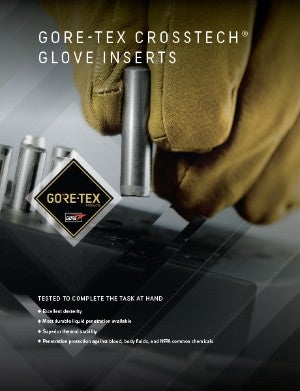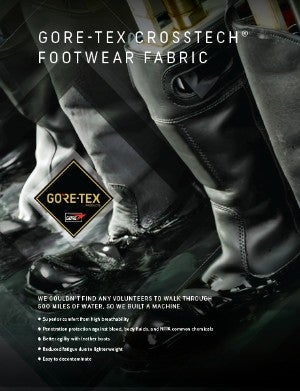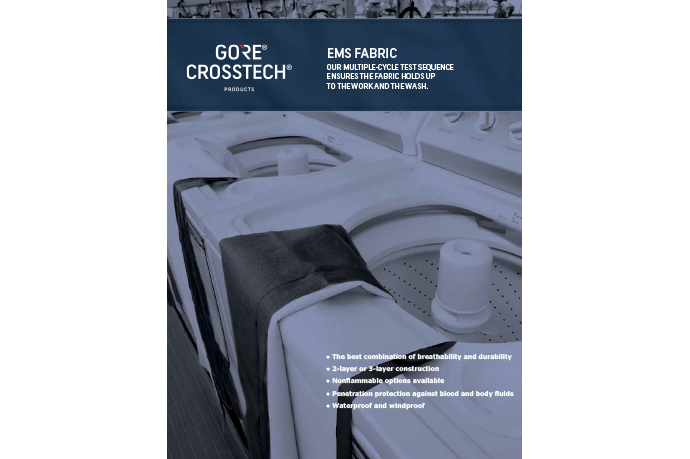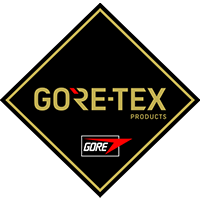[EN-US] Marketing Materials Page - GORE-TEX CROSSTECH® FOOTWEAR FABRIC - Downloadable
[EN-US] Marketing Materials Page - GORE® CROSSTECH® products - EMS - Downloadable

As a firefighter, you face a broad range of challenging environments, and working in turnout gear is tough on your body. You definitely need protection against extreme heat, but the vast majority of your calls don’t involve this kind of challenge. Nevertheless, heat is still a problem, and the heat you encounter during most calls can contribute to heat stress.

SMALL INCREASES MATTER
The human body can be extremely sensitive to small increases in core temperature. U.S. military studies have shown that once your temperature reaches 100°F, each increase of 0.1°F is physiologically significant, leading to an increased risk of heat exhaustion.

YOUR CHOICE OF PROTECTIVE BARRIER MATTERS
A recent human study evaluated the physiological impact of protective barriers currently available in turnout gear. Conducted by a third party, this study confirmed that wearing the GORE® PARALLON™ liner system delivered the highest breathability followed closely by GORE® CROSSTECH® black moisture barrier. Both of the GORE® protective barriers performed significantly better than the competition. In fact, 40 percent of the trial participants could not finish the test when wearing the competitive barrier because their heart rates exceeded their maximum rates, which were established as part of the safety criteria before the trial began.

THL VERSUS RET TEST METHODS
Testing the performance of the materials in your gear can provide valuable information for gear selection. The THL test has done a great deal of good for the firefighter, helping to improve how well gear can shed excess body heat; but it evaluates performance in a relatively mild environment, similar to a conditioned office space. And, it has been found that THL does not provide very useful information about how gear performs, particularly in warm or sunny conditions. The RET test can provide some of this valuable insight, which could be important to you in your gear selection.
In addition, THL did not predict the differences seen in the human trials, whereas the RET testing did.
YOUR JOB IS TOUGH, AND NO GEAR CAN CHANGE THAT. BUT TURNOUT GEAR WITH GORE® PROTECTIVE BARRIERS MANAGE HEAT STRESS SIGNIFICANTLY BETTER THAN THE COMPETITIVE BARRIER. YOU WORK IN ALL TYPES OF CONDITIONS...SO SHOULD YOUR GEAR!

Your boots play an important role in your protection and safety, and for years, there has been thought that leather boots provided better footing. Now, thanks to a joint research study by Auburn University and the University of Mississippi there is support for this thinking.
In the study, professional firefighters participated in fire simulation activities wearing rubber boots and then leather boots, separated by a rest period. The results of the study indicated that the firefighters were four times more likely to have a hazardous slip when wearing rubber boots than when wearing leather boots.
In cases where departments may prefer leather boots for improved comfort and agility, budget constraints may result in settling for rubber boots with an initial cost between $100 and $200 less than leather. However, the cost of potential injury may not be considered in these decisions.
Based on a recent NFPA report of line-of-duty injuries, more than 14,700 firefighters (out of 1.1 million) were injured because of falls, slips, or jumps in 2011, and the National Safety Council has determined that the average cost for a slip/fall injury was $41,393.
Bringing these figures closer to home...in a department with 1,000 firefighters*, the above reports' data would suggest that approximately 12 members would have sustained a slip/fall injury in 2011, for a total cost of almost $500,000. Additionally, based on the data from the universities' research study, wearing leather boots instead of rubber can potentially lower a fire department's rate of slip/fall injury by 4 times – translating to saving your department $375,000, or $375 per firefighter.
Data suggests that spending $100 to $200 for premium leather boots can increase traction, reduce the number of injuries, and potentially save $375 in medical costs – not to mention the lost time incurred and hardship for fellow firefighters!
*Individual department size and statistics may vary.
[EN-US] Leather boots - Downloadable
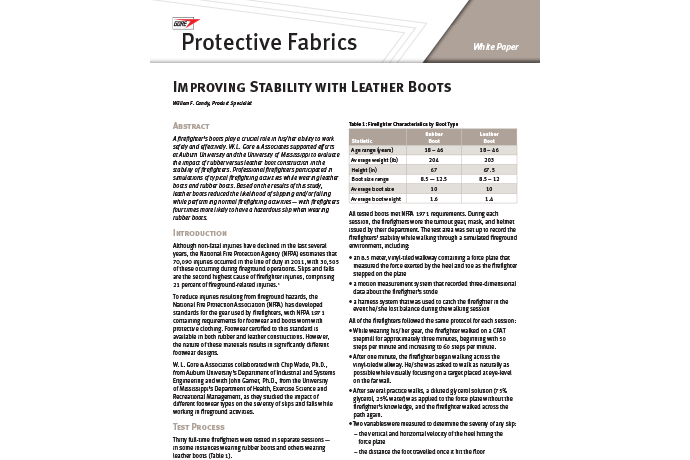 Gore_Protective_Fabrics_WhitePaper_FINAL 6-23-15.pdf
Download PDF
Heat and Flame
Fire & Safety
GORE-TEX CROSSTECH®
Gore_Protective_Fabrics_WhitePaper_FINAL 6-23-15.pdf
Download PDF
Heat and Flame
Fire & Safety
GORE-TEX CROSSTECH®

Gore tested the long-standing theory that rubber decontaminates better than leather. The results were surprising: leather samples were found to retain less residual chemical contamination than rubber samples following decontamination procedures. The tests were conducted using a FEMA testing protocol, which focused on chemicals that firefighters are likely to encounter in the field, including carbon disulfide (CS2), tetrachloroethylene, isooctane (gasoline), acrylonitrile, dimethyl formamide (DMF), and diethyl amine.
Read the Fire Engineering article about the decontamination study.
[EN-US] Decontamination study: Rubber vs. Leather - Downloadable
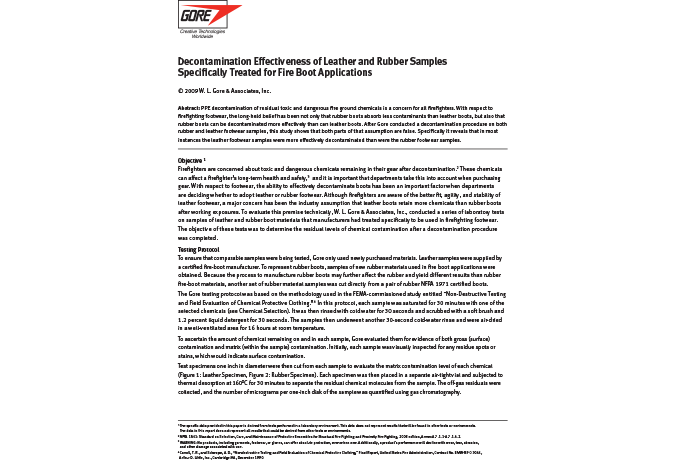 Decontamination effectiveness of leather and rubber_FINAL_Oct2011.pdf
Download PDF
Heat and Flame
Fire & Safety
GORE-TEX CROSSTECH®
GORE-TEX CROSSTECH Footwear
Decontamination effectiveness of leather and rubber_FINAL_Oct2011.pdf
Download PDF
Heat and Flame
Fire & Safety
GORE-TEX CROSSTECH®
GORE-TEX CROSSTECH Footwear

A group of firefighters wearing turnout gear completed a defined work/rest cycle in a controlled environment as their body core temperatures, heart rates, and skin temperatures were monitored. Over a period of several weeks, the same participants repeated the trial three times so they could wear each set of gear containing one of the three different protective barriers. And the results are exceptional:
- The GORE® protective barriers delivered the highest breathability — significantly better than the competition.
- All of the firefighters were able to complete the trial while wearing gear with GORE® protective barriers; on the contrary, 40 percent could not finish the test when wearing the competitive barrier because their heart rates exceeded their maximum, which were established as part of the safety criteria before the trial began.
- RET results directly correlated with the participants’ physiological responses, whereas THL did not.

Increase in Body Core Temperature
U.S. military research has shown that once a body core temperature of 100°F is reached, each increase of only 0.1°F is physiologically significant, leading to an increased risk of heat exhaustion. At the end of the human trial, the average increase of body core temperature varied depending on the protective barrier in the gear. The GORE® PARALLON™ liner system performed the best, followed closely by the GORE® CROSSTECH® black moisture barrier; however, the increase with the competitive barrier was the largest. These results confirm that GORE® protective barriers are the most breathable.

Body Core Temperature Response to Work/Rest Cycle
Rest cycles are crucial to enable your body to recover from the strain of the challenging environments in which you work. When the participants were wearing the GORE® PARALLON™ liner system or GORE® CROSSTECH® black moisture barrier, the rest periods were more effective and they were able to complete the entire trial; when they wore the competitive barrier, their temperatures continued to rise rapidly. In fact, 40 percent of them were pulled out during the second work cycle because their heart rates exceeded their maximum rates, which were established before the trial began.

RET (Resistance to Sweat Evaporation) versus THL (Total Heat Loss)
Testing the performance of the materials in your gear can provide valuable information for gear selection. The THL test has done a great deal of good for the firefighter, helping to improve how well gear can shed excess body heat; but it evaluates performance in a relatively mild environment, similar to a conditioned office space. And, it has been found that THL does not provide very useful information about how gear performs, particularly in warm or sunny conditions. The RET test can provide some of this valuable insight, which could be important to you in your gear selection.
Before the trial began, each turnout gear composite was measured for THL and RET. While THL did not predict the differences seen in the human trials, the RET testing did. In fact, the THL results, which are what is commonly available to fire departments today, indicated that there should be NO difference in performance between the gear tested in this study. However, the trial confirmed that there were significant differences—the Gore technologies were more breathable and had a lower burden on the firefighters, as demonstrated by lower core temperatures, lower skin temperatures, and lower heart rates.
ELKTON, Md. (September 16, 2019) – W. L. Gore & Associates announced its next generation in hood technology with the highly breathable GORE® Particulate Hood GEN2. This enhanced design delivers improved comfort, certified protection, and long-lasting durability at an affordable price.

COMFORT
The level of comfort you get from the GORE® Particulate Hood GEN2 has been improved for a more natural feel without compromising protection. Its highly breathable construction helps reduce heat stress, enabling you to wear the hood longer at the fireground.
PROTECTION
The GORE® Particulate Hood GEN2 exceeds requirements of the NFPA 1971, 2018 Edition for both particulate-blocking and thermal protection. Its innovative design integrates a barrier that blocks more than 99.99 percent of particles between 0.1 and 1.0 microns in size. It delivers reliable protection throughout the entire hood — blocking smoke at critical seams more effectively than other particulate hoods currently available. At the same time, its construction is optimized to reduce interference with sounds and signals on the fireground.
RELIABILITY
The exceptionally durable GEN2 hood retains its level of more than 99.99 percent particulate-blocking performance even after laundering. The hood’s unique inspection opening enables you to inspect the entire hood — inside and out.
According to Holly Blake, North American product manager in Gore's Fabrics Division, the fire industry continues to recognize the need for protection against exposure to fireground contaminants. "In 2017, Gore addressed the vulnerability of firefighters' head and neck areas by delivering the first hood certified to the NFPA 1971, 2018 Edition's option for particulate protection." She continued, "Based on feedback from firefighters, we have improved the comfort of the GORE® Particulate Hood GEN2 with a new design and increased breathability. At the same time we maintained the high level of particulate protection and reliability of our original hood. To deliver quality consistent with the original hood, we have continued to work with Majestic Fire Apparel to manufacture the GEN2 hood."
Available in two knit options — Ultra C6 (black) and Nomex® blend (white) — the GORE® Particulate Hood GEN2 is being sold through Majestic Fire Apparel’s dealers. Visit majhoods.com/Gore or GoreParticulateHoods.com for more information about this new product.
ABOUT MAJESTIC FIRE APPAREL
Majestic Fire Apparel, Inc. (MFA) is a premier manufacturer of fire-retardant hoods, accessories, and ARC-rated apparel. With facilities located in Lehighton, Pennsylvania, MFA is an ISO 9001 registered company that maintains a compliant Quality Management System. MFA is committed to the pursuit of better products that achieve optimal benefits for the fire service. The company’s focus on quality and new product development has attributed to its success in serving customers in the fire and safety industry for more than 20 years. majhoods.com.
ABOUT GORE
W. L. Gore & Associates is a global materials science company dedicated to transforming industries and improving lives. Since 1958, Gore has solved complex technical challenges in demanding environments — from outer space to the world’s highest peaks to the inner workings of the human body. With more than 10,500 Associates and a strong, team-oriented culture, Gore generates annual revenues of $3.7 billion. gore.com.
# # #
MEDIA CONTACT
Lon Edelman
W. L. Gore & Associates
105 Vieve's Way Elkton, MD 21921
Telephone: +1 410 392 3600
ledelman@wlgore.com
GORE, Together, improving life and designs are trademarks of W. L. Gore & Associates.

